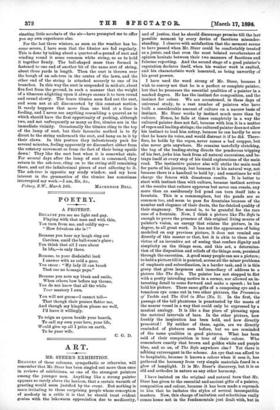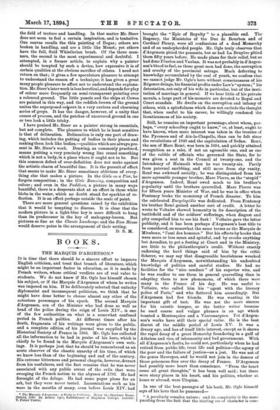ART.
MR. STEER'S EXHIBITION.
READERS of these columns, sympathetic or otherwise, will remember that Mr. Steer has been singled out more than once in reviews of exhibitions, as one of the strongest painters among the younger men. Anything like a strong painter appears so rarely above the horizon, that a certain warmth of greeting would seem justified by the event. But nothing is more irritating to those surprising people whose conception of modesty in a critic it is that he should treat evident genius with the lukewarm appreciation due to mediocrity,
and of justice, that he should discourage promise till the last possible moment by every device of facetious misunder- standing. I observe with satisfaction that the moment seems to have passed when Mr. Steer could be comfortably treated as a jester, and that even the most belated reverberators of opinion hesitate between their two manners of facetious and fulsome reporting. And the second stage of a good painter's reputation declares itself, when his weaker work is exalted, and his characteristic work lamented, as being unworthy of his great powers.
I have used the word strong of Mr. Steer, because I wish to convey not that he is a perfect or complete painter, but that he possesses the essential qualities of a painter in a marked degree. He has the instinct for composition, and the instinct for colour. We are accustomed, in these days of universal study, to a vast number of painters who have built a considerable amount of culture on a narrow basis of instinct. Mr. Steer works by instinct much more than by culture. Hence, he fails at times completely in a way the cultured painter does not fail, because with him it is a matter of ropes and leading-strings; the cultured painter does not allow his instinct to lead him astray, because he can hardly be sure that he hears its voice, and would distrust it if he did. There- fore, he holds by the ropes, never comes a bad cropper, but also never gets anywhere. He remains tastefully clutching, the tug of the leading-string directs the ponderous tripping of his feet, jerks him back from all natural excursions, and be- trays itself at every step of his timid explorations of the main road. The instinctive painter also will strike the main road for parts of his journey, but because it is his natural way, not because there is a handrail to hold by ; and sometimes he will charge the fences with disastrous results. It is better to start with instinct than with culture, because instinct arrives at the results that culture approves but never can create, any more than an assiduously fed pond can turn itself into a fountain. This is a commonplace, but the ponds are so common too, and seem to pass for fountains because of the number and elegance of their ducts, the far-fetched quality of their stagnancy. The moral is, to be grateful for the rare case of a fountain. Now, I think a picture like The Sofa is enough to prove the presence of this original living source of painter's vision, an energy that relates the picture, in its degree, to all great work. It has not the appearance of being modelled on any previous picture, it does not remind one directly of this master or that, but it is akin to them all in virtue of an inventive act of seeing that confers dignity and simplicity on the things seen, and this act, a determina- tion of the disposition and reliefs of the things seen, persisted through the execution. A good many people can see a picture; to hold a picture till it is painted, across all the minor problems of emphasis and subordination, is a harder task, and it is this grasp that gives largeness and immediacy of address to a picture like The Sofa. The painter has not stopped to flirt with a pretty intruding motive in a corner, nor allowed an in- teresting detail to come forward and make a speech ; he has held his picture. These same gifts of a composing eye and a tenacious eye come out in two other pictures, the Procession of Yachts and The Girl in Blue (No. 3). In the first, the passage of the tall phantoms is punctuated by the masts of the nearer vessel in a way that could only be expressed by a musical analogy. It is like a fine piece of phrasing upon the metrical intervals of bars. In the other picture, how freshly the inspiration has been held, and how directly presented ! By neither of these, again, are we directly reminded of pictures seen before, but we are reminded of the same qualities in good pictures. What has been said of their composition is true of their colour. Who remembers exactly that brown and golden white and purple blue, and so on, of The Sofa anywhere else ? Yet there is nothing extravagant in the scheme. An eye that can afford to be hospitable, because it knows a colour when it sees it, has gathered the harmony from very simple materials fused in a glow of lamplight. It is Mr. Steer's discovery, but it is as old and orthodox in nature as any other harmony.
I have insisted on the original and natural turn that Mr. Steer has given to the essential and ancient gifts of a painter, composition and colour, because it has been made a reproach to him that he imitates the styles of several incompatible masters. Now, this charge of imitation and eclecticism really comes home not in the fundamentals just dealt with, but in the field of texture and handling. In that matter Mr. Steer does not seem to feel a certain inspiration, and is tentative. One canvas recalls the thin painting of Degas ; others are broken in handling, and are a little like Monet ; yet others have the full, fluid Whistlerian brush. Of the three man- ners, the second is the most experimental and doubtful. I attempted, in a former article, to explain wby a painter should be tempted by such a device, how expressive it is of certain qualities at the obvious sacrifice of others. I need not return on that; it gives a few speculators pleasure to attempt to understand the reason of a technique; it has given a great many people pleasure to affect not to understand the explana- tion. Mr. Steer's later work is less heretical, and depends for play of colour more frequently on semi-transparent painting over a coloured ground. The little panels and the ships at Cowes are painted in this way, and the reddish-brown of the ground unites the superposed coVairs in a very carious and charming series of greys. It has the danger, however, of a unity that comes of process, and the patches of uncovered ground in one or two look a little tricky.
I have praised Mr. Steer as a painter strong in essentials, but not complete. The pleasure to which he is least sensitive is that of delineation. Delineation is only one part of draw- ing, which includes the putting of bodies in their places and making them look like bodies,—qualities which are always pre- sent in Mr. Steer's work. Drawing, as commonly practised, means putting a very precisely wrong line round something which is not a body, in a place where it ought not to be. But this common defect of over-definition does not make against the artistic charm of beautiful line. It is the pursuit of effect that seems to make Mr. Steer sometimes oblivious of every- thing else that makes a picture. In the Girls on a Pier, he forgets composition ; in the Girls Running, composition and colour ; and even in the Paddlers, a picture in many ways beautiful, there is a desperate shot at an effect in those white blobs in the water, which no doubt stand for sparkles of re- flection. It is an effect perhaps outside the scale of paint.
There are more general questions raised by the exhibition that it would be tempting to discuss. It is clear that the modern picture in a light-blue key is more difficult to bang than its predecessor in the key of mahogany-brown. But pictures so fine as the Classic Landscape and the Sion House would deserve pains in the arrangement of their setting.
D. S. M.



































 Previous page
Previous page